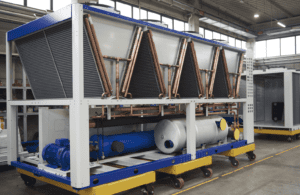Chillers play a key role in many businesses, from cooling systems in office buildings to temperature control in industrial environments
Whether you’re using air-cooled, water-cooled, glycol chillers, or heat pumps, regular servicing is important to keep everything running as it should. But how often should you service your chiller? The answer depends on what it’s used for, how heavily it’s running, and the kind of system you have in place.
While there are some general best practices, the frequency of chiller servicing really does vary by industry and usage. In some sectors, skipping a service could mean disrupted production or loss of stock. In others, it might mean higher energy bills or a shortened system lifespan.
Let’s look at how servicing needs differ depending on how a chiller is used, and what signs to watch for between maintenance visits.
Chiller maintenance basics
All chillers benefit from planned servicing. At a minimum, even low-demand systems should be checked over once a year. This helps catch issues like refrigerant leaks, blocked filters, or worn parts before they turn into serious problems. A well-serviced chiller unit also runs more efficiently, which can make a noticeable difference to energy costs over time.
A standard service visit might include tasks like cleaning condenser coils, checking the oil and refrigerant levels, testing control systems, and inspecting valves and pumps. For water-cooled systems, water treatment checks are also important to prevent scale and corrosion.
The amount of wear a chiller takes on depends not only on how often it runs but also on the environment it’s in. Systems exposed to dirt, moisture, or chemical fumes will need more frequent attention than those in clean, temperature-controlled spaces.
How usage affects service intervals
It’s easy to assume all chillers should be serviced once a year, but that’s not always enough. A small unit in a back-office air conditioning setup will have very different needs compared to a large industrial system running 24/7.
For example, chillers in data centres often run constantly and cannot afford any downtime. In these cases, monthly visual checks and quarterly servicing may be the norm. Similarly, food production facilities or pharmaceutical companies must maintain strict temperature control, so they often follow a tighter maintenance schedule.
In contrast, systems used seasonally—such as those in schools or leisure centres—may only need full servicing before and after the peak months. However, it’s still worth checking that the system hasn’t been affected by damp, dust, or freezing conditions during its downtime.
Different types of chillers, different requirements
The type of chiller unit you have also affects how often it should be serviced.
Air-cooled chillers are typically easier to maintain, with fewer components that require water treatment. However, they’re exposed to outdoor conditions and often gather dust, leaves, and debris. This means cleaning needs to be more frequent, particularly during spring and autumn.
Water-cooled systems require more in-depth care. Because they rely on a cooling tower, they can be prone to limescale, algae, and other build-up inside the system. These chillers usually need servicing two to four times a year, depending on water quality and load.
Glycol chillers, used in brewing, food storage, and other temperature-sensitive processes, have their own set of maintenance needs. The glycol concentration should be tested regularly, and leaks need to be dealt with promptly to avoid contamination or corrosion.
Heat pumps used for both heating and cooling also require a slightly different maintenance approach. Because they reverse their cycle throughout the year, both the heating and cooling functions need regular checks. In most cases, servicing twice a year—once in spring and once in autumn—is a good rule of thumb.
Industry-specific considerations
Different industries place different demands on their cooling systems. For instance:
Manufacturing: Downtime can lead to production losses, so regular checks are scheduled to avoid disruptions. Maintenance is often tied to production cycles.
Healthcare: Hospitals and labs need a stable climate for equipment and medication storage. Here, reliability matters more than efficiency, so systems are often checked monthly.
Hospitality: Hotels and event venues may only need seasonal servicing unless they run year-round. However, any breakdown can affect customer experience, so inspections are still frequent.
Retail and storage: Cold storage and supermarket refrigeration units are typically serviced quarterly or even monthly, especially when storing food or pharmaceuticals.
Signs that your chiller needs attention
Even with a scheduled maintenance plan, it’s important to watch for signs that your chiller might need a service sooner than planned. These include:
Unusual noises or vibrations
Rising energy bills without a change in usage
Inconsistent temperature control
Water leaks or puddles around the unit
System alarms or error codes
If you spot any of these, it’s worth getting the system looked at sooner rather than waiting for the next planned visit. Otherwise, you may encounter a problem that necessitates a 24/7 emergency breakdown chiller unit repair.
Servicing helps with more than just reliability
There’s a strong link between servicing and energy efficiency. A chiller that’s clogged with dust or running on low refrigerant has to work harder to do the same job. That means it uses more power, and parts wear out faster. Regular servicing helps the unit run as it should, which saves money in the long run.
Proper maintenance can also extend the lifespan of the system. Rather than dealing with unexpected breakdowns or replacing a chiller earlier than expected, keeping it in good condition from the start is a much simpler approach.
Final thoughts
There’s no one-size-fits-all answer to how often a chiller should be serviced. It depends on your system type, your industry, and how often the equipment runs. As a general guide, annual servicing is the minimum, but many businesses benefit from more regular checks. The goal is to catch small issues early, reduce energy costs, and keep everything working smoothly.
Whether you’re looking after a compact heat pump for a small office or a large industrial glycol chiller, a well-thought-out service schedule makes all the difference.
















